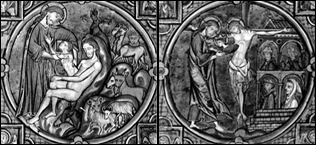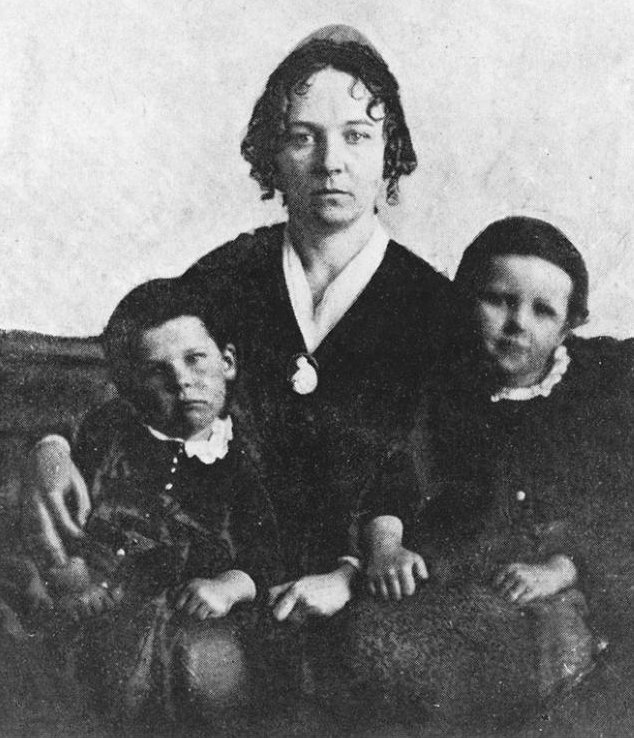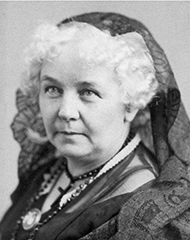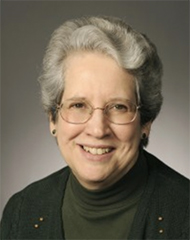 |
|
| |
| Class Prep |
|
|
| |
Feminist Biblical Studies in the First & Second Waves
 - Today's readings allow us to explore what feminist biblical interpretation looked like during the first wave of the feminist movement.
-
- Elizabeth Cady Stanton (1815–1902) is pictured to the right with two of her sons around the time of the first woman's rights convention in Seneca Falls, New York (1848). She came to believe that the right to vote was important, but that much deeper work was needed to alter the deep-seated patriarchal presuppositions of western culture. She believed that the Bible had been used to justify sexism, but that it also had been misinterpreted to that end by men, who had reserved its interpretation to themselves for centuries. Convinced that a feminist interpretation of the text would be liberating to women, she invited women to help her reinterpret the text, but only seven joined her in producing The Woman's Bible (1895, 1898; their initials follow the paragraphs they wrote).1 As you read the excerpts from her text and Clifford's discussion of her work, be able to answer the following questions:
-
- What meaning is made of the simultaneous creation of the human as male and female in Genesis 1:26-28?
- In what ways has Genesis 2 been used to support the "battering rams" of sexist interpretation, according to Stanton's authors?
- How does The Woman's Bible read the sequence from adam or earth creature (האדם) to man/woman (איש/אישה) in Genesis 2 differently from second-wave feminist Phyllis Trible?
- How does Stanton "undo" sexist interpretation of the story of Eve's (and Adam's) fall and curse?
- If you were a third-wave feminist, what fault might you find in these first-wave readings of the Bible?
-
- Clifford will summarize where feminist biblical scholarship has gone since the first wave; be able to identify the main developments and methods she mentions.
-
-
-
- Assigned Readings
-
- Primary:
- Genesis 3
- 1 Timothy 2:8-15
- Elizabeth Cady Stanton, ed., excerpts on Genesis and 1 Timothy from The Woman’s Bible (1895; 1898), excerpted in Kristen E. Kvam, Linda S. Schearing and Valarie H. Ziegler, "The Women’s Bible," in Eve and Adam: Jewish, Christian, and Muslim Readings on Genesis and Gender (Bloomington, Indiana: Indiana University Press, 1999) 346-56 (Camino)
- Secondary:
- Anne M. Clifford, "Feminist Perspectives on the Bible," in Introducing Feminist Theology (Maryknoll, New York: Orbis, 2001) 46-86 (Camino)
- online class prep
- Writing Focus:
- Entering the conversation (They Say/I Say 1-16)
-
- Slides for Lecture
-
-
- Today's Authors
-
| |
 |
Elizabeth Cady Stanton (1815-1902) was a prominent activist in the abolition movement before the American Civil War, and a leading figure in the 19th-century women's rights movement. While she is often credited with co-founding the women's suffrage movement in the United States, her interests ranged well beyond voting rights to family law, property rights, birth control, and temperance. |
| |
 |
Anne M. Clifford is Associate Professor Emerita at Iowa State University, former president of the College Theology Society, and a religious sister in the Congregation of the Sisters of St. Joseph. Her teaching and research focuses on Christian theology and the natural sciences, Catholic social teachings, theologies of creation and ecology, environmental ethics, and feminist theology and spirituality. |
-
-
- Further Reading
-
- de Groot, Christiana and Marion Ann Taylor. Recovering Nineteenth-Century Women Interpreters of the Bible. Atlanta: Society of Biblical Literature, 2007.
-
- Gifford, Carolyn De Swarte. "American Women and the Bible: The Nature of Woman as a Hermeneutical Issue." In Feminist Perspectives on Biblical Scholarship (ed. Adela Yarbro Collins; Biblical Scholarship in North America 10; Chico, California: Scholars Press, 1985) 11-33.
-
- Kroløkke, Charlotte and Anne Scott Sørensen. "Three Waves of Feminism: From Suffragettes to Grrls." In Contemporary Gender Communication Theories and Analyses: From Silence to Performance (Thousand Oaks, California: Sage, 2005) 1-23.
-
- Russell, Letty M., ed. The Liberating Word: A Guide to Nonsexist Interpretation of the Bible. Philadelphia: Westminster, 1976.
-
- Selvidge, Marla J. Notorious Voices: Feminist Biblical Interpretation, 1500–1920. New York: Continuum, 1996.
-
- Sohn-Kronthaler, Michaela and Ruth Albrecht, eds. Faith and Feminism in Nineteenth-Century Religious Communities, Bible and Women/An Encyclopaedia of Exegesis and Cultural History 8. Atlanta: SBL Press, 2019.
-
- Stanton, Elizabeth Cady. The Woman's Bible, 2 vols. Seattle: Coalition Task Force on Women and Religion, 1974–1998. Reproduction of original, New York: European Publishing Company, 1895–1898.
-
- Styler, Rebecca. "A Scripture of Their Own: Nineteenth-Century Bible Biography and Feminist Biblical Criticism." Christianity and Literature 57:1 (2007) 65-85.
-
- Terborg-Penn, Rosalyn. African American Women in the Struggle for the Vote, 1850–1920, Blacks in the Diaspora. Bloomington: Indiana University Press, 1998.
-
- Willard, Frances E. Woman in the Pulpit. Chicago: Woman's Temperance Publishing Association, 1889.
-
- Zolty, Shoshana. And All Your Children Shall Be Learned: Women and the Study of the Torah in Jewish Law and History. New York: Aronson, 1993.
-
-
- Acknowledgements
-
- Image: Elizabeth and Two of her boys around the time of the First Women's Rights Convention (Seneca Falls, New York, July 19-20, 1848). Reproduced from The History Chicks, "Episode 36: Elizabeth Cady Stanton," The History Chicks (13 February 2013), online, http://thehistorychicks.com/episode-36-elizabeth-cady-stanton/, accessed 16 January 2020.
-
-
- 1 Some of the "facts" mentioned in these paragraphs are incorrect—but then, none of these women could receive proper academic training in the scriptures (and our knowledge of the Bible's historical context has changed in the past century). For example,
-
- it is likely that not all records were lost in the Babylonian (not Assyrian) conquest and exile in 588 BCE (p. 348);
- the compilation of the Torah took place after the Babylonian Exile, in the Persian period (539–332 BCE), not the Hellenistic period (she lists 247, 226, or 169 BCE)
- ;.
- the "first" story of creation in the left column on p. 349 should be labeled "Priestly" rather than "Elohistic" (this was likely an error in male scholarship of the time); and
- the pun "Womb-man" on p. 352 works in English but not in the original Hebrew, where the words for man and woman (איש/אישה) are unrelated to the term for womb (רחם).
|
|
| |
|
|
| | | |
